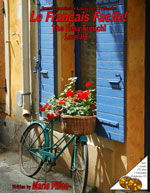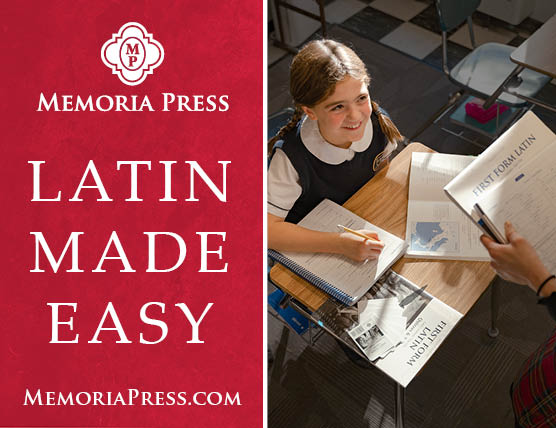A number of features make Le Français Facile! (The Easy French!) a good choice for Christian homeschoolers: it works with all ages from about kindergarten through adult, it does not require a parent/teacher who already knows French, it has Christian content, and it uses a variety of methods based on research about foreign language acquisition. Author Marie Filion has an extensive background in literacy training, in teaching French, and in curriculum development—all of which have equipped her to produce a first-class, thoughtfully developed program.
There are four courses for the program, plus an introductory "junior" level for young children which I will review last. The publisher originally published the first two levels as Level I, and they still offer that option. However, the revised version is presented as levels IA and IB, and it is followed by levels IIA and IIB.
I'll begin my review with Level I, the original large volume.
All students from about second grade through high school can begin with Level I which consists of a 374-page spiral-bound book and two enhanced CDs that run on either your computer or a CD player. The CDs have professionally recorded conversations and vocabulary pronunciation for each lesson. In addition, they have PDF files for about 200 worksheets and planning/record-keeping pages that you can print as needed.
At the beginning of the book, Marie shares some background on the program and how it is put together. She says that a younger child (elementary grades) should take about three years to complete the first level, then spend two years each on the next two levels for a total of seven years of study. An older, independent learner might complete each level in one year. Marie claims that the three levels will provide all a high school student needs for his foreign language requirement.
The CDs feature a variety of speakers, and the recording is crisp and clear. The conversations and vocabulary are printed out in the text so students can follow along reading the words if they wish. They should listen to the conversations and vocabulary frequently whether or not they do this with the book. Instruction is written in English.
Lessons are set up with basic lesson instructions for the teacher working with a younger child, followed by additional instructions for older, independent learners. The independent learner follows the "Lesson Planner Template" in the front of the book, using the assigned parts of each lesson. There are plenty of hands-on activities--arts and crafts projects, drawing, cooking, "prayer watch," missionary project, map making, and more--from which you choose. You will likely use more of these with younger children.
Christian content is apparent throughout the program. Students learn "witnessing" vocabulary. Great Commission Languages has also arranged for those who have completed Level I to send their book and CDs to Wycliffe Bible Translators as a donation, then receive a credit for 30% off Level II. (Instructions for this Missionary Rebate Program are on the first page.)
The methodology is based on a number of ideas which I can touch on only briefly in this review. The program begins with cognates and phonograms that are familiar to English speakers. It uses a "French Weave" technique where sentences mix both English and French words so that vocabulary is learned in a meaningful, easily understood context. Gradually more and more French is used in sentences. This is a conversational approach, but it is balanced with more explicit grammar instruction once in a while for younger students and much more frequently for the independent student.
Students work on learning phonograms as they do in intensive phonics programs for English such as The Writing Road to Reading, although Le Français Facile! is not as complicated. (Younger students do not actually start learning phonograms until the second and third years in Level I.) It seems to me that the "phonogram" approach is especially helpful for learning French since some of the pronunciations are so different than those we use in English.
Students create notebooks. While younger children's notebooks are likely going to feature more drawings and less writing, those of older students will include sections where they write out vocabulary words, idioms, and grammatical information.
Independent students also need to obtain a French-English Student Dictionary and a reference book of fully-conjugated verbs. The Big Book of French Verbs: 555 Fully Conjugated Verbs by Stillman and Gordon is recommended.
Each lesson includes other components that vary from lesson to lesson. There are a variety of activities from which to choose; these reinforce the lesson content but are not essential. Activities are often coordinated around a theme such as a storybook that relates to France. Examples of some activities are "Read The Giraffe That Walked to Paris by Nancy Milton. Try and say the French words with their proper French pronunciations...." "Study the difference in climate between northern France and southern France...."
A section of "Teacher Helps" in each lesson provides some additional information such as usage rules for the teacher and independent learner.
"Scripture Memory Work" instructs students to copy Scripture verses in French onto worksheets with a scroll format. The verses are on p. 34 in the book, presented on track 50 of the first CD, and also printable from the CD.
"Cultural Notes" add interesting information about French culture. Trivia is an additional bit of information, usually historical.
There is a section on the aforementioned notebook work, then "Front Cover Work" which is an art activity.
"Everyday Vocabulary" suggests ways to work on incorporating French into your daily conversations. Three Everyday Vocabulary lists are recorded on the first CD at a slower than normal speed so that sounds are easy to distinguish.
"Things to Remember" appear as needed to point out essential grammatical concepts such as the changes in adjectives depending upon the gender of the noun they are describing.
In addition, there are worksheets on the CDs that also reinforce the lesson with additional activities. These more frequently request the student to draw or illustrate something rather than write in French.
Overall, Level I serves well as an introduction to French. It does not emphasize vocabulary memorization as do most programs, but instead uses a variety of strategies to help the student acquire vocabulary in a more natural fashion. Of course, much depends upon how much the student then practices listening, repeating, and attempting to use French words on his or her own. I like the way independent learners are given additional instruction that really does take them beyond a merely conversational approach.
Parents do need to make some decisions about which activities to do. Some might be tempted to breeze through lessons, skipping over the activities, but that would undermine the nature of the program that uses the activities to help make language acquisition easier than in a more traditional program.
Children should not begin the second level before at least fifth or sixth grade. It assumes a solid foundation in English grammar—the names and uses of various parts of speech, verb tenses, and conjugations. Junior high or high school would be the better age range at which to tackle the second level.
The second level works on vocabulary, grammar, and usage, continuing to focus on developing conversational fluency. Students completing these first two levels should have the equivalency of two years of high school French.
A unique characteristic of the second level is that students work through the lessons once during the first semester primarily learning vocabulary and conjugations, then they work through the same lessons a second time focusing more on grammar and orthography (spelling and usage). The introduction explains that during the first semester students should be listening for meaning, while in the second semester, students should practice mimicking the speakers to develop fluency.
The split versions of both levels I and II target an older audience—seventh graders and above. They are written more for the independent student. Some of the lesson material and "stories" have been rewritten for an older audience. Activities for younger children (e.g., coloring) have been omitted. Lessons are more structured with fewer choices. Maybe the most significant difference is that activity pages are included within the main book rather than on the supplemental CD.
In addition, there are separate test books and answer keys to the split books, although these might also be used for most lessons in the single volumes. Interestingly, the publisher has labeled the test books by grades levels: Grade 7 for IA, Grade 8 for IB, Grade 9 for IIA, and Grade 10 for IIB.
Even with the worksheets printed out in the texts, students still continue to compile their own notes in composition books on phonograms and rules. For the second level, they also keep a writing journal in French.
Split books also include two CDs each. These contain the audio tracks for each lesson, plus such items as practice with high-frequency words, Scripture memory verses, and French songs. The single volumes' CDs include activity sheets and keys, while split volumes' CDs have only the answer keys since activity pages are already printed in the books.
For Level I and above, students need to practice with phonogram cards. These are printed in the back of the single-volume Level I on standard weight paper. For other volumes, they are printable from the CDs. Great Commission Languages also sells a set of cards printed on heavier card stock that you might want to purchase.
The Junior Level targets grades K through 2. It takes a conversational approach and leaves most of the grammar for later. It uses the "French weave" just as it does in the upper levels to introduce French vocabulary within the context of familiar English sentences. There are more stories and songs and less grammar and writing.
As with the other levels, there are two CDs. They have printable activity sheets, audio tracks for each lesson, and French songs.
Activities and games play prominent roles in lessons at this junior level. Also, there are frequent references to The Ultimate Lapbook Handbook for instructions on creating different types of lapbooks.
At the beginning of the book are brief biographies of famous French men and women, most followed by recommended books or DVDs that you might use to learn more about them.
You might also use some of the fiction books from the suggested list to help children become familiar with French culture and its stories.
The Junior Level of Le Français Facile! has much more content than most foreign language programs written for young children. You might take two to three years to complete it, depending upon the age and ability of your child, although an older child (maybe in grades 2-4) might complete the program in one year.
If you want to investigate more before purchasing there are sample lessons on the website or there is The Easy Sampler CD with the first five lessons. It has everything you need to teach a younger child, and all but the phonogram cards needed to teach an older child. The $15 cost can be applied against the purchase of a complete program.









